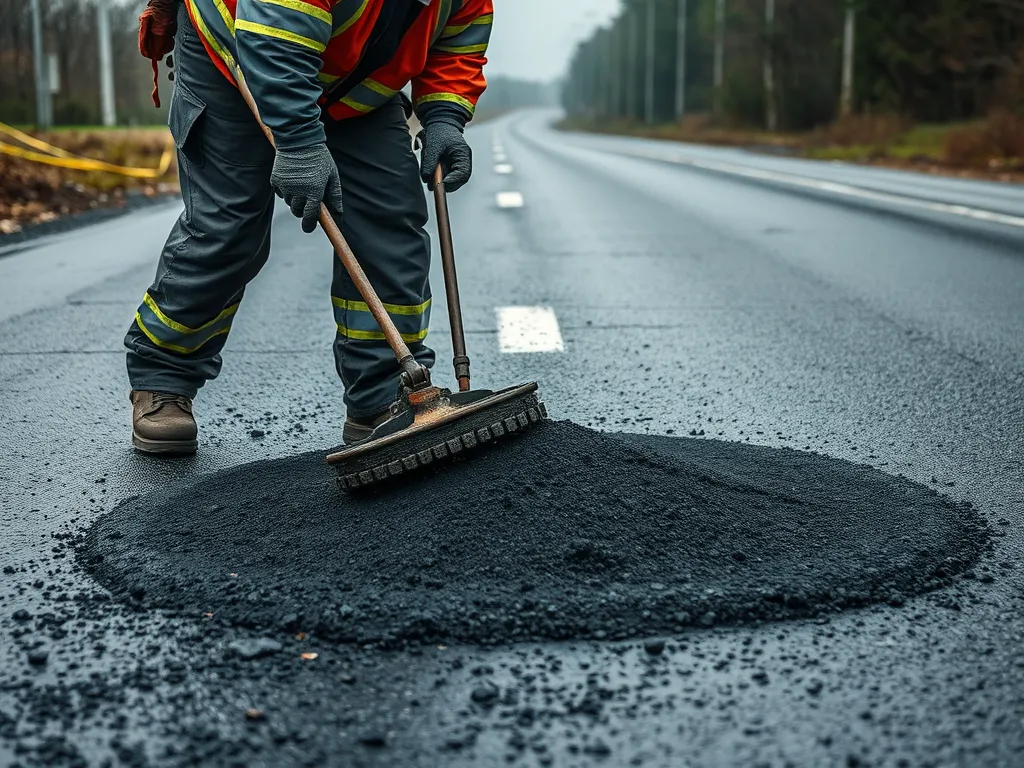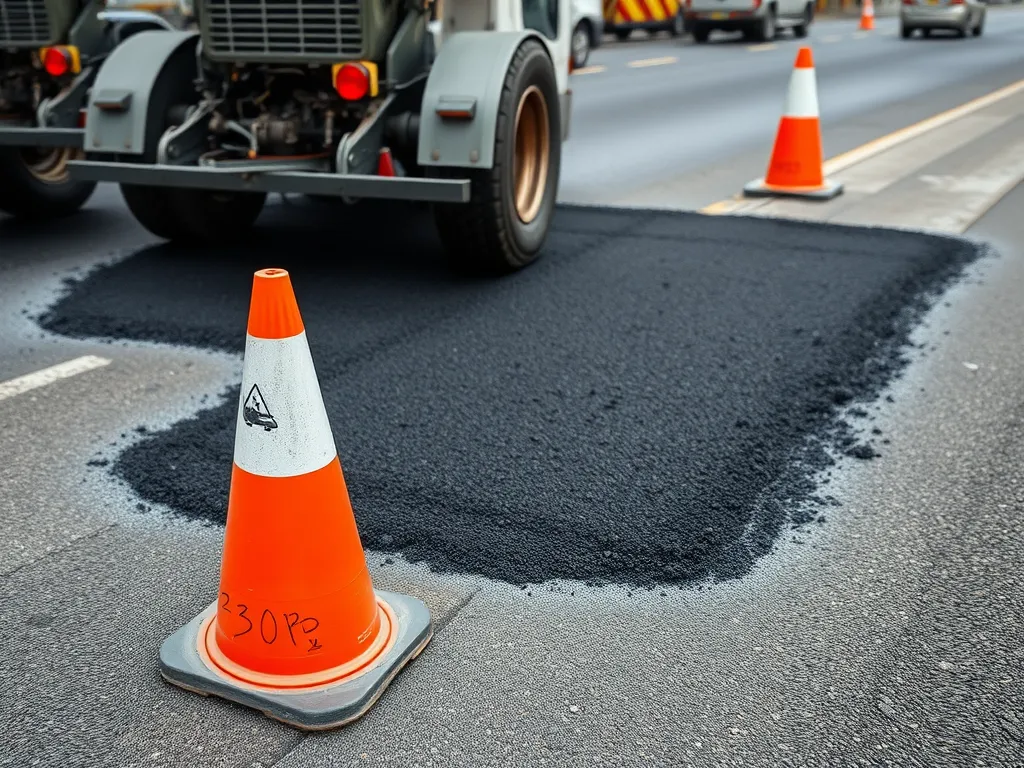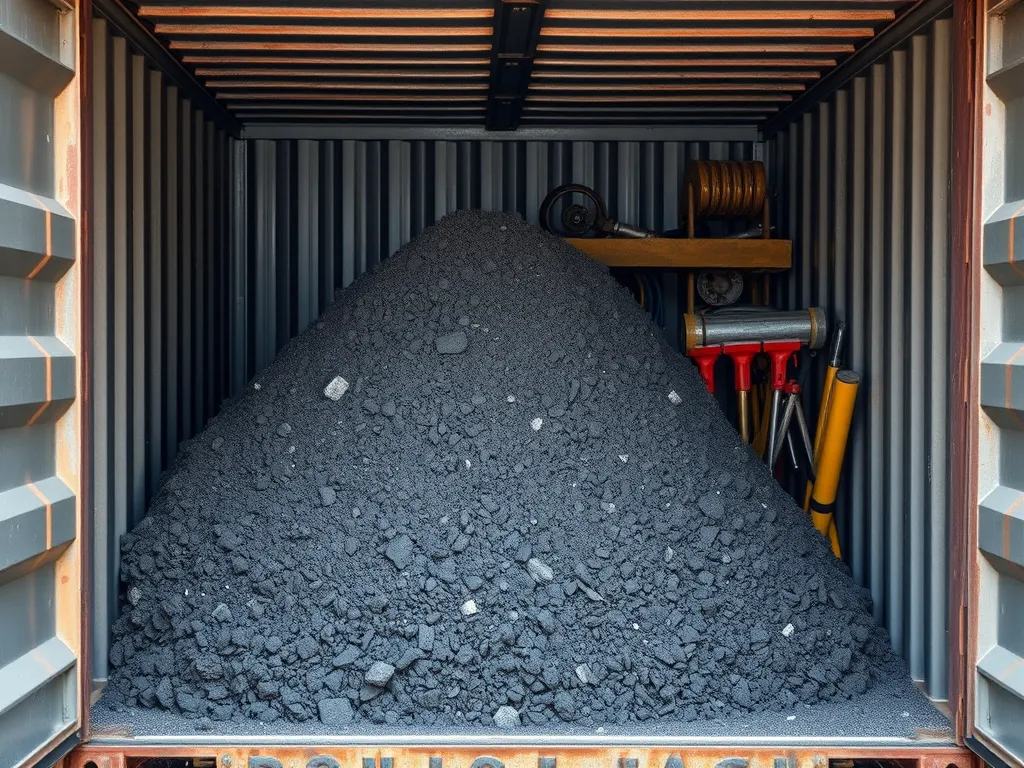Cold Mix Asphalt: Your Go-to Solution for Emergency Repairs
Published on: October 13, 2025 | Last Updated: April 14, 2025
Written By: George Voss
Cold mix asphalt is a ready-to-use material designed for quick fixes on roads, driveways, and parking lots when time or weather rules out hot mix alternatives. Made from aggregates coated in bitumen emulsion (a binding agent), it requires no heating and hardens at ambient temperatures. Unlike hot mix asphalt, which needs 300°F+ temperatures for application, cold mix works in any weather – even sub-freezing conditions. Ideal for potholes, cracks, or edge repairs, it’s sold in 50 lb bags ($8-$15 each) at hardware stores and requires only basic tools like tampers or shovel blades.
This article breaks down how cold mix asphalt works in urgent scenarios. You’ll learn its pros (instant traffic readiness) and cons (shorter lifespan), plus step-by-step patching methods. We’ll compare products like EZ Street and QPR, explain compaction tricks for lasting results, and share storage tips to keep material workable. Whether you’re a homeowner tackling a driveway crater or a crew fixing a winter-damaged road, we’ve got the specs and strategies to make your repair stick.
Contents
- What is Cold Mix Asphalt?
- Advantages Of Cold Mix Asphalt for Emergency Repairs
- Disadvantages Of Cold Mix Asphalt
- Step-by-step Application Process
- Equipment and Materials for Effective Repairs
- Performance and Durability Factors
- Storage and Handling Guidelines
- Frequently Asked Questions (FAQ)
- Closing Thoughts
- Useful References for You:
What is Cold Mix Asphalt?
Cold mix asphalt is a ready-to-use paving product for quick fixes. It stays soft in cold temps and needs no heat. Unlike hot mix, it uses a special binder that stays workable until packed down.
Definition and Composition Of Cold Asphalt Mix
Cold asphalt mix blends crushed stone or gravel with bitumen emulsion. This liquid binder coats the stones at low temps. Additives like polymers boost grip and block water. Most mixes use 4-7% bitumen by weight to balance strength and flex.
Key Differences From Hot Mix Asphalt
Cold patch works without heat or big gear. Hot mix needs 300°F heat and plant gear. Cold mix sits in bags for months. Hot mix must be poured the day it’s made. Cold fixes handle traffic in 1-2 hours. Hot mix lasts 8-12 years; cold patch holds 6-18 months as a temp fix.
Now that we’ve covered the basics, let’s break down why cold mix asphalt excels in urgent repair jobs.
Advantages Of Cold Mix Asphalt for Emergency Repairs
Cold mix asphalt delivers unique benefits for urgent pavement fixes. Its design tackles common challenges faced during road emergencies.
Rapid Application in Cold Weather Conditions
Cold patch asphalt works in temperatures as low as 20°F. Unlike hot mix, which requires 275°F heating, cold asphalt mix stays pliable in freezing conditions. This allows crews to fill potholes during winter storms or frosty mornings. Products like asphalt mix for cold weather maintain adhesion even when thermometers drop below 40°F.
No Heating or Special Equipment Required
Skip the asphalt plant and heavy machinery. Cold asphalt repair needs only basic tools: shovels, tampers, and brooms. Brands like QPR or EZ Street cold patch asphalt blend come ready-to-use straight from the bag. Municipalities save $500-$1,200 per job by avoiding hot mix trucks and rollers.
Immediate Traffic Readiness for Emergency Situations
Vehicles can roll over cold patch asphalt within 15 minutes of compaction. The blend’s high-viscosity emulsion bonds aggregates instantly. This makes asphalt cold patching material ideal for busy roads handling 500-1,000 cars daily. Highway crews often pair it with temporary signage for swift lane reopenings.
Cost-effective Solution for Temporary Repairs
Cold mix asphalt costs $25-$40 per 50lb bag versus $100-$200/ton for hot mix. Small crews can patch 10-15 potholes daily with minimal labor. For short-term fixes lasting 6-12 months, it cuts project budgets by 30-50% compared to full-depth replacements. Municipalities stockpile cold blended asphalt for winter road maintenance programs.
While cold mix excels in urgent scenarios, its limitations become apparent for permanent repairs. Let’s examine key drawbacks to consider before your next project.

Disadvantages Of Cold Mix Asphalt
While cold mix asphalt excels in emergency scenarios, its trade-offs require careful evaluation. Temporary fixes demand compromises in performance and durability.
Limited Longevity Compared to Hot Mix
Cold patch asphalt typically lasts 6-12 months versus hot mix’s 5-10 year lifespan. The absence of heat during production creates weaker bonds between aggregates and bitumen. Freeze-thaw cycles accelerate deterioration, making it unsuitable for high-traffic roads or permanent repairs. A 2023 study showed cold asphalt mix fails 3x faster than hot mix under daily vehicle loads exceeding 500 axles.
Weather Sensitivity During Application
Though applied in cold weather, most cold patch asphalt blends require temperatures above 40°F for proper adhesion. Rain or snow during installation washes away unset binder, creating voids. High humidity above 70% slows curing, extending hardening times from 24 hours to 3 days. Always check forecasts—repairs made below 25°F may crack within weeks.
Compaction Challenges in Deep Potholes
Filling holes deeper than 2 inches risks inadequate compaction. Cold asphalt repair materials lack the fluidity to self-level, requiring manual tamping. Hand tools often achieve 85-90% density versus pneumatic rollers’ 95%+ in hot mix projects. Poorly compacted layers trap moisture, accelerating pavement breakdown. For cavities exceeding 4 inches, layer the cold patch asphalt blend in 1.5-inch increments with intermediate compaction.
Mastering the next step—proper installation methods—can counterbalance these limitations. Let’s break down the process.
Also See: Common Uses for Asphalt in Residential and Commercial Settings
Step-by-step Application Process
Preparing the Repair Area: Cleaning and Shaping
Start by clearing debris, loose asphalt, and water from the pothole or crack. Use a broom, air blower, or shovel. Square the edges with a chisel or saw for better bond strength. Shape the hole to have vertical walls—no overhangs. Dry the area fully. Moisture weakens cold mix asphalt repair bonds.
Selecting the Right Cold Patch Asphalt Blend
Pick polymer-modified blends (like QPR or UPM) for high-traffic roads. Use standard cold asphalt mix for driveways. Check labels for terms like “all-weather” or “freeze-resistant.” Opt for mixes with 3/4-inch aggregate for deep holes. Small cracks need fine-grade cold patch asphaltic concrete. Match product specs to repair depth and traffic load.
Proper Layering and Compaction Techniques
Fill holes in 2-inch layers. Compact each layer with a hand tamper or plate compactor. Apply force—weak packing causes dips. Overfill by 1/2 inch to allow settling. For cracks, press cold asphalt patching material with a trowel until flush. Aim for 95% density to block water seepage. Test with a car tire—no movement means solid repair.
Curing Time and Traffic Management
Let cold patch asphalt cure 24-72 hours. Cold temps (below 40°F) slow hardening. Use traffic cones if cars must pass soon. Drive slow for first 48 hours. Full cure hits in 3-6 weeks. Track ruts—recompact if needed. Hot days speed cure; rainy days delay it.
With the repair set, focus shifts to gear. Proper tools boost cold asphalt repair life and cut rework.

Equipment and Materials for Effective Repairs
Proper tools and materials determine the success of cold mix asphalt repairs. Let’s break down what you need for efficient patching in urgent scenarios.
Essential Tools for Cold Asphalt Patch Installation
Basic tools include a shovel, steel tamper, and gloves. For deeper potholes, use a plate compactor (rental: $75-$150/day) to achieve 92-95% compaction. A propane torch ($40-$80) helps dry wet surfaces before applying cold patch asphalt blend. Keep a wheelbarrow or mixing tub for larger jobs. Road crews often add vibratory rollers for highway repairs requiring 3-4 inches of material.
Choosing the Correct Cold Mix Asphalt Product
Match the product to repair depth and traffic load. Use fine-graded mixes with 3/8-inch aggregates for cracks under 2 inches. Opt for coarse blends (1/2-inch stones) for potholes deeper than 4 inches. Polymer-modified cold asphalt mix for driveways resists rutting better than standard blends. Brands like QPR or EZ Street offer pre-mixed options costing $25-$40 per 50-lb bag (covers 6-8 sq ft at 2-inch depth). Check for PG binder grades matching local climate – PG 64-22 works for temps below 40°F.
Safety Gear and Worksite Setup
Wear ANSI-rated gloves, safety glasses, and steel-toe boots. Set up traffic cones and reflective signs within 50 feet of the repair zone on roads. For night work, add LED arrow boards. Avoid applying cold patch asphalt repair during heavy rain – even 10% moisture can weaken adhesion. Store unused material in sealed containers above 20°F to prevent premature curing.
With the right setup, cold mix asphalt repairs can stabilize surfaces quickly. Next, let’s examine how weather and technique impact the lifespan of these temporary fixes.
Performance and Durability Factors
Cold mix asphalt’s effectiveness depends on material quality, application methods, and environmental conditions. Let’s break down the key elements that determine repair longevity.
How Temperature Affects Cold Patch Asphalt Repair
Cold asphalt mix performs best between 20°F (-6°C) and 100°F (38°C). Below 20°F, adhesion weakens as binders stiffen. Above 100°F, the patch may soften before curing. For winter repairs, select polymer-modified blends like PG 64-28 binders that remain pliable in sub-freezing temps. Summer applications require additives like limestone dust to prevent premature hardening.
Maximizing Adhesion on Driveways and Roads
Proper surface prep ensures cold patch asphalt bonds securely:
- Remove loose debris and water from potholes using brooms/air compressors
- Square vertical edges with chisels for mechanical interlock
- Apply ASTM D4215-approved tack coats on concrete surfaces
Compaction matters: Use 6,000-lb plate compactors for road repairs or hand tampers for driveways. Achieve 92-95% density to prevent water infiltration.
Expected Lifespan Of Emergency Repairs
Well-installed cold asphalt repair lasts 6-24 months. Temporary patches in low-traffic driveways average 12 months. Road repairs under heavy trucks degrade faster – plan for replacement within 6 months. Data from 127 state DOTs shows 70% of cold patch asphalt repairs survive 1+ winter cycles when using high-grade materials like UPM® Cold Mix.
While costs range $1.50-$3.50/lb, premium cold patch asphalt blends extend service life through additives like crumb rubber or recycled shingles. For permanent solutions, consider hot mix asphalt once weather permits.
Proper storage keeps your cold asphalt mix ready for the next emergency – let’s explore best practices.

Storage and Handling Guidelines
Proper storage ensures your cold asphalt repair materials stay workable until needed. Follow these protocols to maintain quality and performance.
Proper Cold Mix Asphalt Storage Conditions
Store cold patch asphalt in sealed containers or heavy-duty bags at 50-80°F. Keep away from direct sunlight to prevent premature curing. Moisture exposure causes clumping – use pallets or racks for ground separation. Unopened bags retain flexibility for 6-12 months under ideal conditions.
Shelf Life and Material Preservation
Most cold asphalt mix products last 12 months unopened. Once opened, use within 3-6 months. Press air out of partially used bags before resealing. For bulk stockpiles, rotate materials using a “first in, first out” system. Check for hardened chunks or oil separation – these signal reduced adhesion capacity.
Environmental Considerations for Unused Material
Dispose of expired cold patch asphalt per local RCRA guidelines. Many plants accept unused material for recycling into new batches. Never landfill petroleum-based products without testing – leached chemicals may violate EPA standards. For small quantities, apply thin layers to non-sensitive areas as temporary erosion control.
Now that your cold asphalt mix is properly stored, let’s address common questions about its real-world performance.
Frequently Asked Questions (FAQ)
Does Cold Patch Asphalt Work for Pothole Repairs?
Yes, cold patch asphalt is specifically designed for pothole repairs. It effectively fills and seals the hole, providing a durable and immediate fix that can withstand traffic shortly after application.
Can Cold Mix Asphalt Be Used for Driveway Repairs?
Absolutely! Cold mix asphalt is an excellent choice for driveway repairs. It can address cracks and surface damage without the need for special equipment or heating, making it a convenient option for homeowners.
How Long Does Cold Mix Asphalt Take to Harden?
Cold mix asphalt typically takes around 24 to 72 hours to cure fully, depending on environmental conditions. In colder temperatures, hardening may take longer. However, it can be used for light traffic just minutes after being compacted.
What is the Cost Of Cold Mix Asphalt for Emergency Repairs?
The cost of cold mix asphalt ranges from $25 to $40 per 50 lb bag. This price is significantly lower than hot mix asphalt, making it a cost-effective option for temporary repairs.
Where Can I Find Cold Mix Asphalt Near Me?
Cold mix asphalt can be found at local hardware stores, home improvement centers, and some construction supply retailers. Additionally, many municipalities stock it for road maintenance and repairs.
How to Accelerate Cold Patch Asphalt Hardening?
To accelerate the hardening process, ensure the repair area is clean and dry before applying the mix. Additionally, using a propane torch to dry moisture in the pothole can help improve adhesion and speed up curing.
Is Cold Patch Asphalt Sold at Major Retailers?
Yes, many major retailers and home improvement chains, such as Home Depot and Lowe’s, carry cold patch asphalt products. It’s advisable to check availability online or call your local store before visiting.
Closing Thoughts
Cold mix asphalt is a viable solution for quick and effective emergency repairs. Its ability to set without heating makes it suitable for various weather conditions. The benefits, such as immediate traffic readiness and cost savings, make it an ideal choice for temporary fixes.
Despite its advantages, be mindful of its limited longevity compared to hot mix asphalt. Proper application and careful site preparation are key to maximizing performance. Following the steps outlined earlier can ensure that your repairs are effective and durable.
For more information on asphalt, repairs, and cost calculators, check out Asphalt Calculator USA. Equip yourself with the knowledge needed to tackle any asphalt project effectively!
Useful References for You:
- Lavin, P. (2003). Asphalt Pavements: A Practical Guide to Design, Production, and Maintenance for Engineers and Architects. London: Taylor & Francis.
- The Basics of Cold Mix Asphalt: What You Need to Know | by High Roads | Medium
- UPM® Cold Mix Asphalt Patch | Cold Patch Asphalt Repair | UNIQUE Paving Materials
- Hot Mix vs. Cold Mix Asphalt for Pothole Repairs | Falcon Asphalt Repair Equipment
- Cold Patch Asphalt Pros, Cons, and Longevity Considerations


